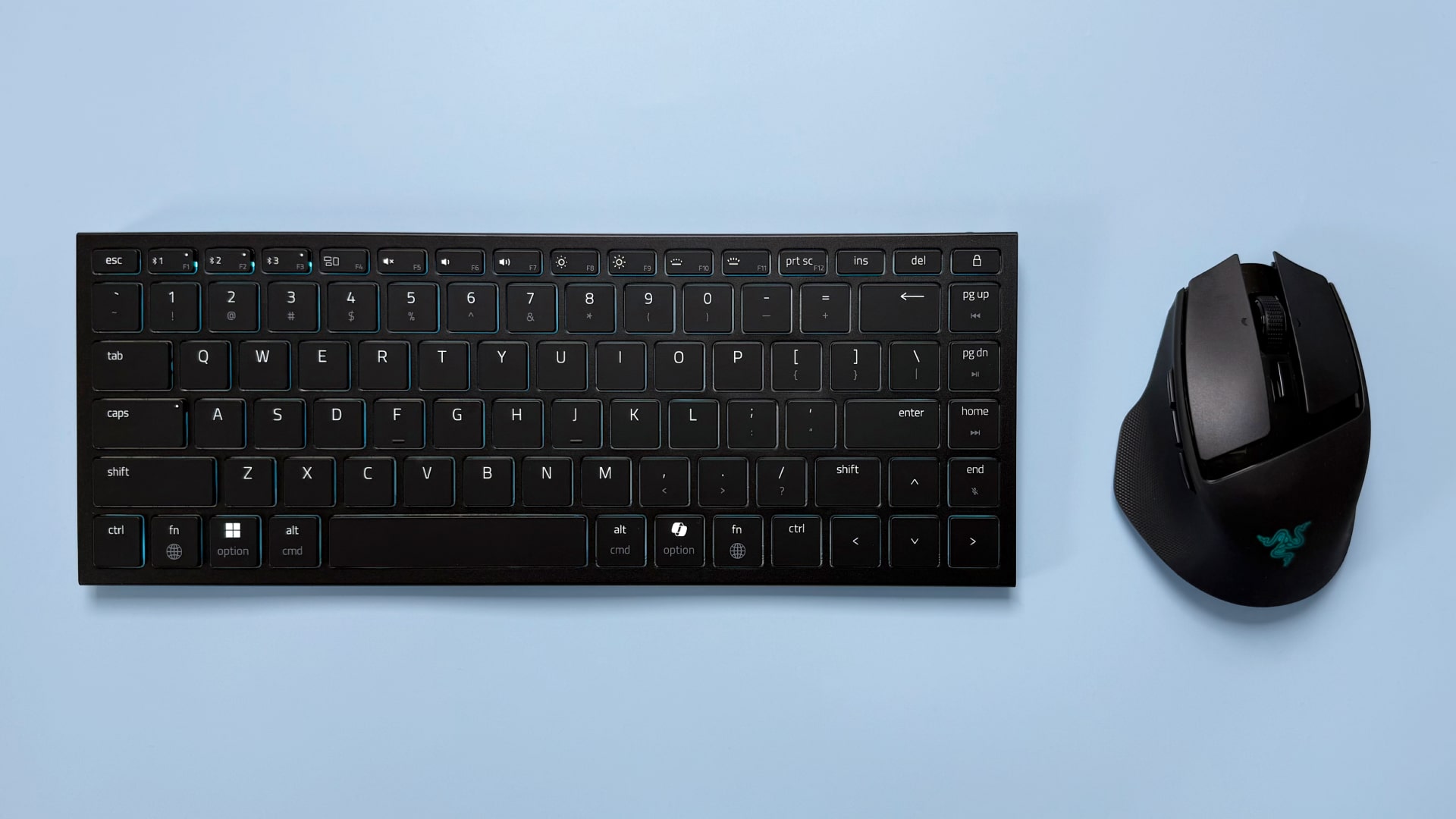Our Verdict
Great featureset at a solid price. Could do with a better audio solution, and more rear I/O.
PC Gamer's got your back
Chipset: Intel Z170
Socket: LGA 1151
Memory Support: 4 x DDR4 DIMMs up to 3600 MT/s, 64 GB max, dual channel, Non ECC, XMP
Form Factor: ATX
Storage: 6x SATA ports, 2x M.2 slots, 1x SATAe
Multi GPU: 2 Way Crossfire (16x4).
PCI-E x16: 2
Rear Panel I/O: 2x USB 3.1, 2x USB 3.0, 2x USB 2.0, 5.1 Audio, Optical S/PDIF Out, RG45 Lan, PS/2 Combo Port, DVI, HDMI
Some corners of the internet would tell you that premium motherboards just aren't worth your money. Certainly, the last 5 generations of Intel chipsets has strengthened that notion. With the dissolution of the north and south bridges way back during the launch of Sandy Bridge, there's very little in the way of performance that comes from the motherboard itself: the quality of your CPU and GPU are paramount.
What does a good motherboard come down to today? Feature sets. What expansion options manufacturers can cram onto a board, how aggressively they can price it, and how it looks. MSI's Z170A Tomahawk makes a strong case for itself with those qualifications. It's an aggressively priced, budget motherboard, aimed at the gamers looking for the largest Z170 feature set at the lowest possible price.
What does 'entry level' get you?
For $150 or £100 you net yourself support for the latest and greatest Intel chipset, Z170. On top of that you get access to Intel's Skylake processors, support for up to 64GB of dual channel DDR4, clocking up to 3400 MT/s, three USB 2.0 ports (one on the board, two in the rear I/O), four USB 3.0 ports (two on board, two rear I/O), and two more USB 3.1 ports located in the rear I/O once again. Unfortunately there's no USB Type C. On top of that there's support for RAID 0, 1, 5 and 10, with up to six traditional SATA 6Gb/s drives, and support for two-way Crossfire running 16x4.
You also have access to one M.2 PCIe x4 lane, allowing data read and write speeds up to five times faster than the limited bandwidth of SATA gen 3. A fully separated PCB for the audio components is a nice touch, ensuring as little electrical noise will make it between your rig and your audio outputs. Although, that's nothing we haven't seen before.
Aesthetics
You know, it's nice to see motherboard manufacturers deviate from those traditional colour schemes we've all grown accustomed to. Let's face it, the "gamer's love red and black" adage is getting pretty old at this point. The Tomahawk is a small step back from this ethos. MSI has thrown in just a small hint of white into the overall design, speckling the chipset and VRM heatsinks with just enough deviation to pull it away from those gaming centric designs. Hell, it's even PC Gamer's official colours, and we can't argue with a board like that, can we?
MSI has also included snazzy under glow LED lighting to the mix. Located on the underside of the board, these LEDs glow red out from under your case's stand-off points. And although it doesn't add a great deal of additional value, it certainly adds a fraction of pop to an area that sorely needed it. In fact it reminds me of some of those custom case mods, utilising light-boxes and single LEDs to illuminate focus points in the builds. Now if this was a white light, or even RGB, that's something I'd be interested in.
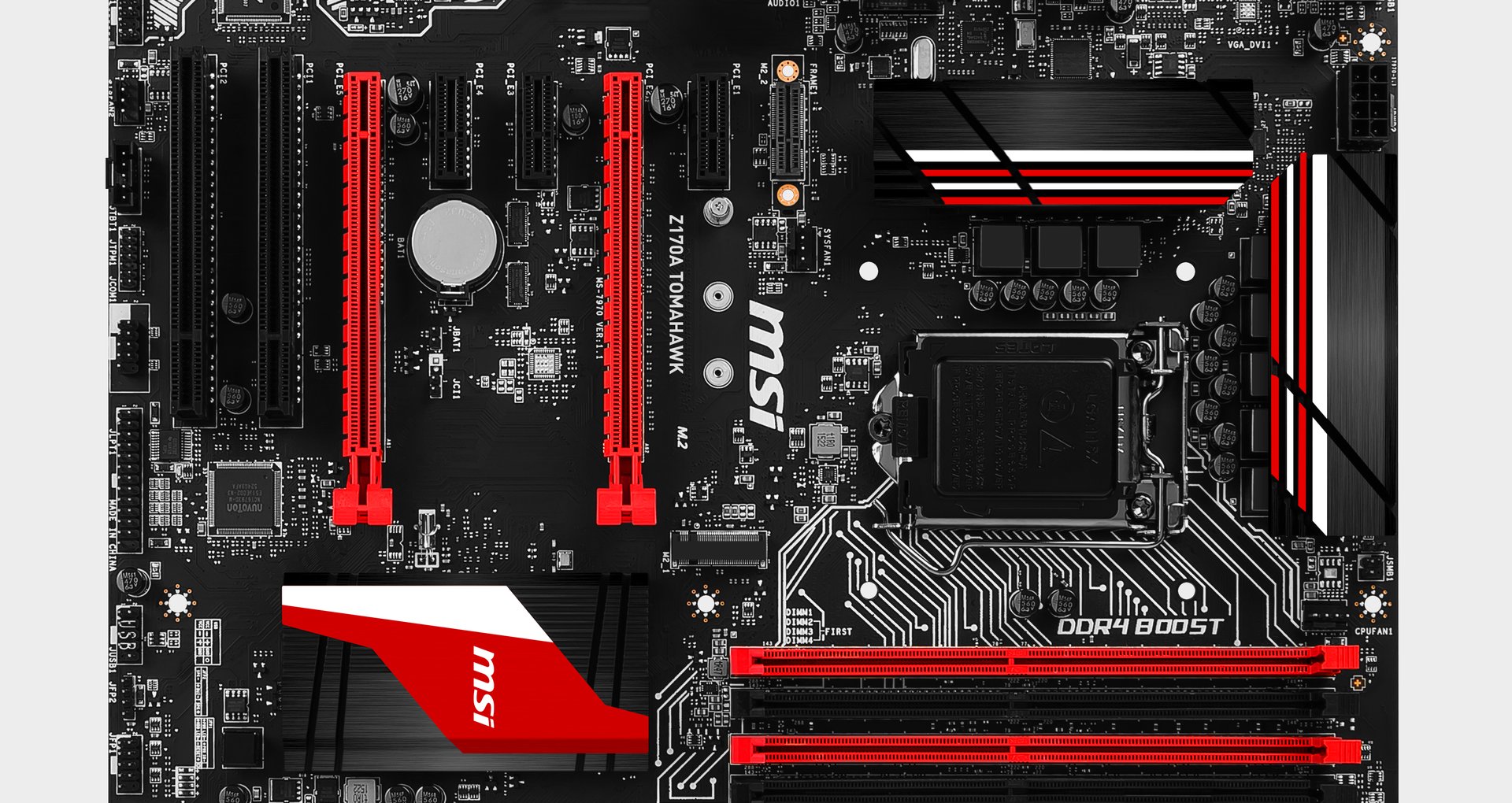
How does it perform?
If you're running at stock frequencies the Tomahawk fares particularly well. It even gives some of MSI's own premium motherboards a run for their money. The Z170A Gaming M7, for example, scores only one point higher in CineBench R15 at stock. That being said, under load, the M7 ran rings around its younger brother, drawing 28W less from the wall at peak load.
What does that mean for you? The less wattage you pull from the wall, the less kWh you'll use over the course of your gaming sessions, and the less money you'll be paying on your electricity bill. Couple that with needing a far smaller power supply for your system, and you're on track to save yourself a nice bit of change over the course of your new system's lifetime.
The scores between these boards are just so similar, is it worth buying a premium motherboard?
As far as overclocking goes, the Tomahawk performed admirably, easily reaching our target frequency of 4.9 GHz. That's no small feat, and we did have to push 1.41V into the VCore to enable this, along with disabling the EMI spectrum. Not great for audio, but perfect for reaching those higher frequencies. Unfortunately we couldn't push it past that like we could with Asus's Maximus VIII Extreme, but that's a $450 board vs a $150 board, and well, is that extra price really worth it?
Generally I don't talk about gaming when we review motherboards here at PC Gamer. That's not to say we don't perform those benchmarks—but out of the 14 Skylake motherboards I've tested, they all achieved a staggering average frame rate of 27 fps in Shadow of Mordor's benchmark at 4K, every single one, regardless of whether that was DDR3 or DDR4, Z170 or B150.
Ultimately we've begun to face that age old problem once more. The scores between these boards are just so similar, that we have to ask, is it worth buying a premium motherboard? For the average Joe, probably not. For those looking for more expansion options, stronger audio solutions and more aesthetically pleasing boards, definitely.
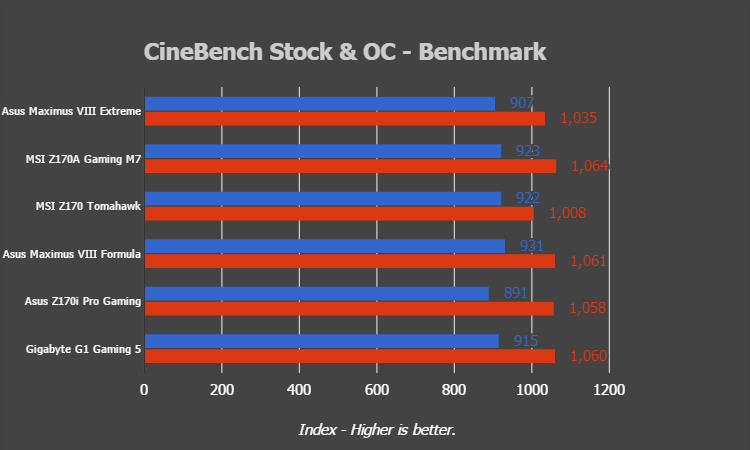
All boards were tested at their maximum overclock 4.9 GHz (or 4.95 GHz for the Asus Maximus VIII Extreme). Higher is better.
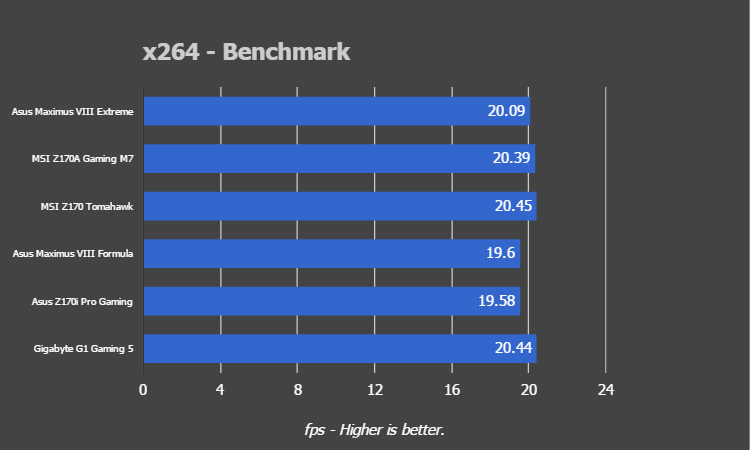
A longer render test than CineBench, all motherboards were tested at stock frequencies. Higher is better.
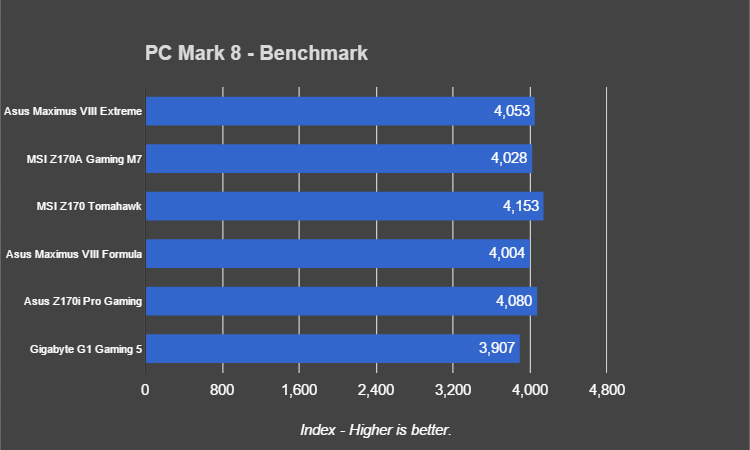
PC Mark Index runs can vary by 100 points per run, each test is ran three times to provide an average. Higher is better.
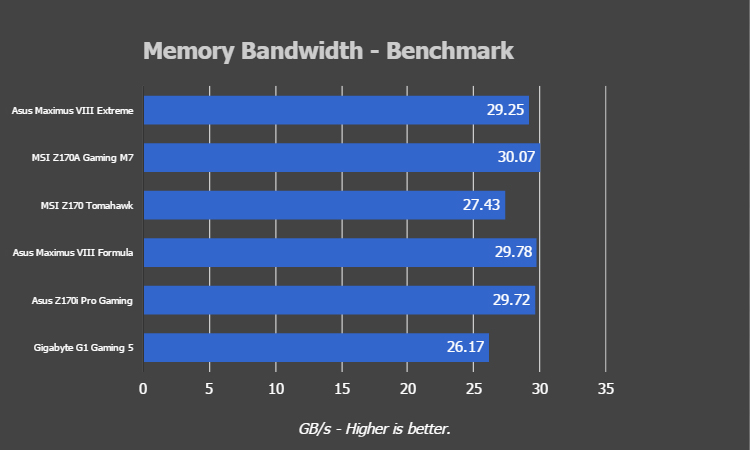
Higher is better.
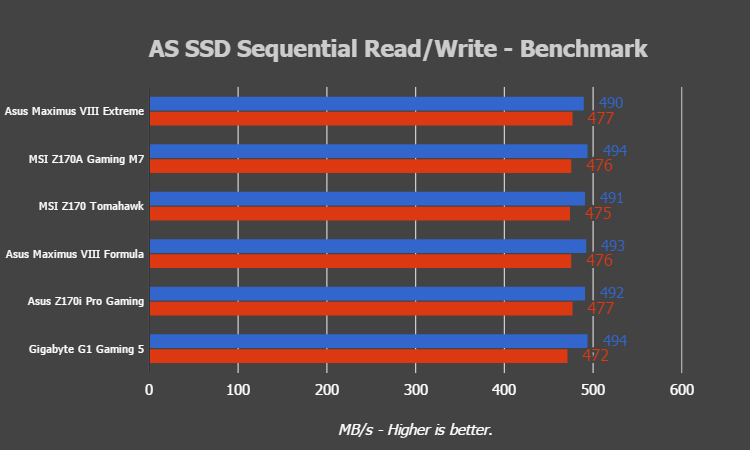
This is ran on the 500GB Samsung Evo 850 SSD. Red indicates write, blue indicates read speed.
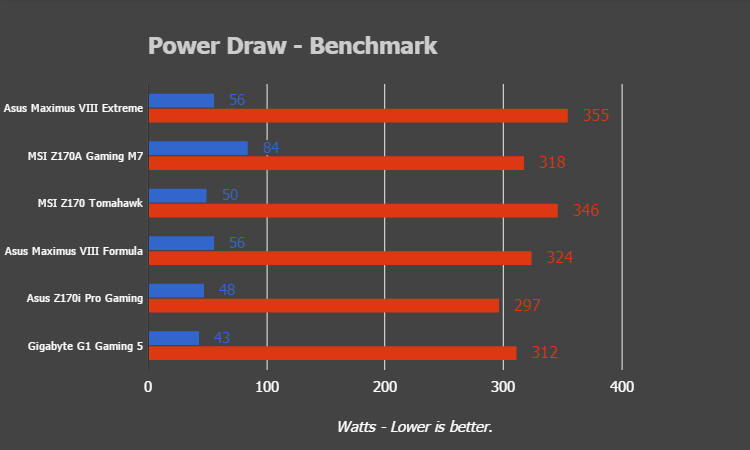
Power draw test is Prime 95's blend test & one instance of Furmark's 1920x1080 GPU burn test, no AA. The torture tests are then ran for 5 minutes, and averages taken.
All tests were performed using an Intel Core i7-6700K, GeForce GTX 980, 16GB Corsair DDR4 @ 2400MT/s, a 500GB Samsung Evo 850 SSD and a 2TB Samsung Pro 850 SSD.
What are the caveats?
With a fairly sound feature set, competitive performance and a £100 price point, the Tomahawk must slip up somewhere, right? Unlike the M9, the Tomahawk lacks the reinforcing armoured backplate and rear I/O cover of a more premium board, and overall that makes it feel a little frail. It's certainly not a huge issue, especially considering the price point, but it's just something to bear in mind. Don't worry, once this baby's installed in your chassis, you could mount all the heavy air towers and GPUs in the world and still not have an issue.
The audio solution, despite the separated PCB, is unfortunately a little weak. I'd love to have seen a more powerful headphone amplifier included, swappable op-amps, a better DAC and some EMI shielding.
On top of that, you lose out on SATA Express, although honestly we're pretty sure that's a dead standard at this point in time. There's also fewer rear I/O options than we'd have liked. More USB MSI, more USB!
Should you buy this motherboard?
For the price, the Tomahawk is a feature-rich motherboard, ideal for anyone looking to build themselves a budget specced Skylake build. On top of that, if you're looking to get into the world of PC building, coupling this Z170 mobo with a decent i5, a good mid-ranged graphics card (like a GTX 960 or AMD's R9 380X), and it will be more than enough to enjoy any of the latest games without worry.
For the money, it's a bargain, without a doubt. But if you want extra expandability or aesthetics are genuinely a big deal for you, you might want to opt for MSI's Z170A Gaming M7 or M9 instead.
Great featureset at a solid price. Could do with a better audio solution, and more rear I/O.
After graduating from the University of Derby in 2014, Zak joined the PC Format and Maximum PC team as its resident staff writer. Specializing in PC building, and all forms of hardware and componentry, he soon worked his way up to editor-in-chief, leading the publication through the covid dark times. Since then, he’s dabbled in PR, working for Corsair for a while as its UK PR specialist, before returning to the fold as a tech journalist once again.
He now operates as a freelance tech editor, writing for all manner of publications, including PC Gamer, Maximum PC, Techradar, Gamesradar, PCGamesN, and Trusted Reviews as well. If there’s something happening in the tech industry it’s highly likely Zak has a strong opinion on it.



